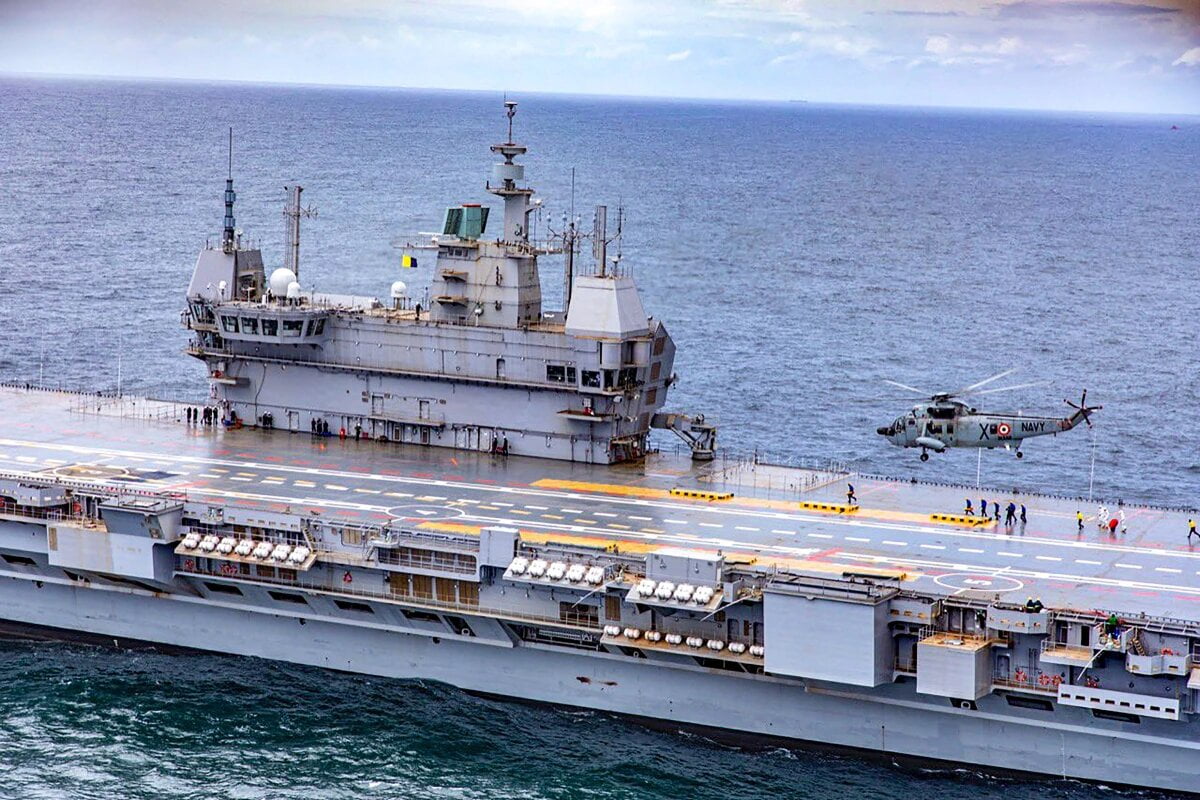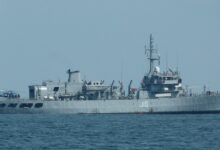‘We’re Geared Up’: Centrepiece Of Navy Vikrant Is Prepared For Commissioning

- The compartment is filled with the scent of fresh paint, and the new flooring is still covered before the ceremony to officially commission the ship.
- The unit that will take action in the event of a fire or flooding on board is the warship's damage control headquarters, located on the fifth deck as well.
Nearly every guy on board India’s newest aircraft carrier, Vikrant, expresses the same sentiment: They are living the dream. This includes the captain, the fighter pilot, the doctor, the engineer, and even the cook.
Naval fighter pilot Lieutenant Commander Ajay Singh says the best day of his career will come when he lands and takes off from the thin runway on this floating airfield. This demanding job carries high risks and is therefore assigned to only the best pilots. He has his arms outstretched towards the expansive flight deck of the largest warship ever built in India.
When working from an aircraft carrier, there is no room for error. The pilot must do his duties within the confines of this seaside airfield, which is swaying up and down in the enormous surf. There could not have been a finer time to join the Navy, in my opinion; that adrenaline is unequalled,” says Singh, a MiG-29K fighter pilot.
To be sure, the Navy has put Vikrant through its paces during a variety of demanding sea trials for nearly a year in advance of its scheduled commissioning into service. Prime Minister Narendra Modi is anticipated to dedicate the first aircraft carrier made in India to the nation on September 1 at Kochi.
However, crucial flight tests must still be completed, and Commodore Vidhyadhar Harke, the warship’s first hand-picked captain, will place the utmost importance on integrating the air wing of the carrier. He is fully aware of the immense responsibility he will bear in revealing the true potential of this 45,000-ton battleship, which will serve as the admirable focal point of the Indian Navy’s homegrown sea might.
Harke explains what is to come while standing in the warship’s flight control centre, which is surrounded by complicated machinery and displays and looks out over a lone MiG-29K produced in Russia that is parked on the flight deck with its wings folded. “My team and I must meet not only the expectations of the Navy but also those of the entire nation.
Additionally, everyone will be observing us as a carrier battle group as we develop (aircraft carriers always move with escort warships). Vikrant’s integration with the rest of the fleet will be just as important as the complicated flight testing, he believes.
The Vikrant, however, wasn’t built cheaply; it is reported to have cost 20,000 crores.
For a nation that must invest heavily in modern military technology to be combat-ready, but whose defence budget has not kept pace with the demands of its armed forces, which are burdened with legacy equipment, getting greater value for the money from the battleship will be important.
“I’m getting good sleep. I am completely confident in my men’s and my aircraft carrier’s skills. We are prepared and motivated, Harke continues.
A few decks below, Lieutenant Commander Y Harsha VR is in charge of the crucial ship control centre and overseeing sailors working in front of multi-function displays and controls that will enable them to monitor vital indicators of the aircraft carrier’s health while it is at sea. The compartment is filled with the scent of fresh paint, and the new flooring is still covered before the ceremony to officially commission the ship.
“A battleship needs to float and move in order to combat. This is the location where it takes place. We create this miniature town by activating the engines, producing water, distributing power, and stabilising the vessel. We’ve all been waiting for this moment, and it’s now here, says Harsha, who has been on board Vikrant for more than two years.
In the six hours that this correspondent was on board, the Indian Navy provided exclusive access for Hindustan Times to the aircraft carrier and organised a number of briefings on a variety of topics, including operations, the function of the commissioning crews, equipment, threat monitoring systems, communications, and logistics.
“A battleship needs to float and move in order to combat. This is the location where it takes place. We create this miniature town by activating the engines, producing water, distributing power, and stabilising the vessel. We’ve all been waiting for this moment, and it’s now here, says Harsha, who has been on board Vikrant for more than two years.
In the six hours that this correspondent was on board, the Indian Navy provided exclusive access for Hindustan Times to the aircraft carrier and organised a number of briefings on a variety of topics, including operations, the function of the commissioning crews, equipment, threat monitoring systems, communications, and logistics.
Ankit Saraswat, a 29-year-old logistics officer who works in one of the galleys on the fifth deck (Vikrant has 14), says his responsibility is to make sure the crew of 1,700 men is fed.
The males will have a wide variety of options, including croissants, quiche, pastries, and freshly made bread. Morale is boosted by food. Every day, the galleys will produce 5,000 meals. Before we set off, we shall stockpile 100 tonnes of rations. The 50 cooks on board are just as eager to embark on the adventure as the rest of us, Saraswat continues.
Even the chefs are aware of the exclusive status India now enjoys because to Vikrant. The only countries with the potential to construct aircraft carriers are the United States, the United Kingdom, Russia, France, and China. It bears the name of the Navy’s INS Vikrant, an aircraft carrier that served from 1961 to 1997.
The unit that will take action in the event of a fire or flooding on board is the warship’s damage control headquarters, located on the fifth deck as well.
The damage control unit, according to the officer in command Lieutenant Commander Akhil Sreerangan, 32, monitors 3,000 fire sensors and 750 flood sensors and is set up to take remote countermeasures. The equipment used in the damage control headquarters were produced locally; according to the Navy, Vikrant has a 76% indigenous content.
Vice Admiral MA Hampiholi, head of the Southern Naval Command, who was on board the warship for an inspection, said Vikrant marks a significant advancement for Aatmanirbharta (self-reliance) in defence and will significantly increase the nation’s maritime power.
The mini-hospital is ready to deploy, according to medical officer Lieutenant Commander Harsha MR, who is looking forward to “the event of a lifetime.” The 40 compartments that make up Vikrant’s medical setup, which is staffed by five doctors and fifteen paramedics, include two operating rooms, a hospital with 16 beds, and even a room with a CT scan.
One of Vikrant’s electrical officers, Lieutenant Shashank Yadav, who is in charge of ensuring seamless internal and external communications, encapsulates the feelings of the younger crew members. Few sailors in the Navy are given this chance. I’m fortunate to be here for my first appointment, declares Yadav.
India now only possesses one aircraft carrier, the INS Vikramaditya, which it purchased used from Russia for $2.33 billion. However, the Navy has argued that given its extensive area of interest, India needs three such floating airfields. Vikrant will be the fourth aircraft carrier that the Indian Navy has operated. The first, Vikrant (of British origin), served from 1961 to 1997; the second, INS Viraat, served from 1987 to 2016; and the third, INS Vikramaditya, served from 2013 onwards.
The ski-jump will be used by the fighters on board the aircraft carrier to take off, and arrestor wires—or, in Navy lingo, STOBAR (Short Takeoff But Arrested Recovery)—will be used to retrieve them.
It will fly a 30 aircraft air wing that consists of MiG-29K fighter jets, Kamov-31 helicopters, MH-60R multi-role helicopters, and modern light helicopters. During tests, helicopters have undoubtedly landed on the flight deck 22 times.
The Navy is looking to purchase a new deck-based fighter, and Vikrant will likely fly it. The Navy has already tested the Boeing F/A-18E Super Hornet and the Dassault Aviation Rafale-M.
It serves as a continual reminder that conducting fighter operations from Vikrant is still a work in progress because there is only one MiG-29K on the flight deck, which is 2.5 times the size of a hockey field. It was taken on board the warship in the form of disassembled kits and put together there.







Facebook Comments